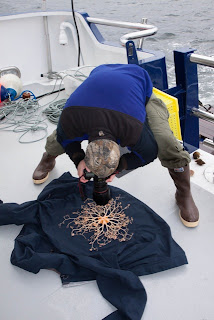I watch a show on The Food Network called Good Eats. The host is Alton Brown and he discusses a large amount of cooking gear and equipment (in addition, to delivering amazing food facts and cooking techniques.) The consistent thing about Alton's gear recommendations is he loves equipment that can multi-task. Why have a piece of gear that can only do one thing. If that is the case, to do three tasks you need three different items. With multi-tasking, one piece of gear does all three jobs.
If you do a lot (or even a little) travel photography the concept of gear "multi-tasking" is hugely important. In the ideal world it would be simple to take all of your gear everywhere. There would never be carry-on limits, space or weight issues, and we would all have our own photo Sherpa. In the real world, we are often forced to take fewer items in order to meet the travel reality.
I found myself in just such a situation on a recent photo trip to Alaska. I normally carry a tripod along with a ball head and a gimbal head. Turns out if I took both my bag would have been 50+ pounds and I did not want to pay the penalty. I decided on just the gimbal since I knew it would work for my long lenses and also provide basic ballhead functionality (although not quite as efficiently.)
Even with that I ended up wanting to shoot a macro shot from directly overhead my subject. My first plan of attack is shown below.
As you can tell, probably not the best way to shoot. Not only is the platform unstable but my ergonomics are horrible. This is a really easy way to hurt your back and take a bad picture at the same time. So I needed to innovate.
My solution was to multi-task my gear. I know I had a great tripod (Really Right Stuff TVC-33) and my gimbal (RRS PG-02). I decided to see if I could make it work in this macro situation.
After looking at the PG-02, I took the vertical support arm and turned it around. This allowed me to support the camera and point it straight down at my basket sea star. I had never done this before and did not know the PG-02 could do this. What I found is exactly what Alton Brown talks about on Good Eats; another great use for a piece of gear designed for something a little (or a lot) different.
Although I had good support, my ergonomics still, for lack of a better word, sucked. Before I destroyed my back, I finally settled on what you see below.
Tremendous support, good ergonomics, and a different view of a basket sea star. After these shots were taken I switched over to an EF 100mm f/2.8L Macro for closer shots (an example is the first shot at the top of the post.)
So here is to Alton Brown, Good Eats, and multi-tasking.
As you all know I love Really Right Stuff gear. This shoot made me an even bigger fan of the RRS PG-02. Good luck making this happen with any of the other gimbal heads out there.
Fiat Lux!
All shots of me are courtesy of Marc Muench, Leanna Telliard-Stern, and Gina Ruttle. Thank you!
Basket stars multi-task as hair!










